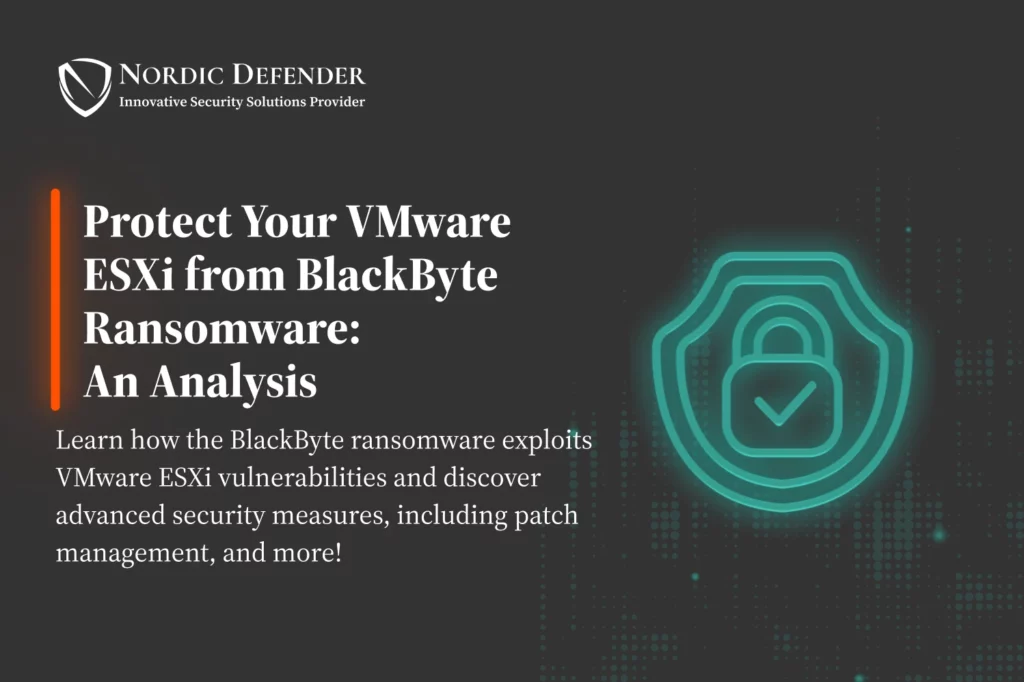The BlackByte ransomware group has been actively exploiting a critical authentication bypass vulnerability (CVE-2024-37085) in VMware ESXi. This flaw allows attackers to gain unauthorized access to the ESXi hypervisor without valid credentials, effectively bypassing authentication mechanisms. Once exploited, attackers can escalate privileges within the VMware vSphere environment, enabling them to control virtual machines (VMs) and further infiltrate the network.
Attack Methodology
The BlackByte group’s approach leverages CVE-2024-37085, an authentication bypass vulnerability within VMware ESXi. This flaw allows attackers to sidestep the standard authentication mechanisms, granting them direct access to the hypervisor. Upon exploiting this vulnerability, attackers often target VMware vCenter, the management layer of ESXi, to escalate their privileges further. This escalation enables the attackers to control or modify virtual machines (VMs) and network configurations across the infrastructure.
Key to the attack is the use of vulnerable kernel drivers, which are executed with high privileges. These drivers can disable core security mechanisms, such as antivirus solutions, EDR, and intrusion detection systems (IDS). Kernel drivers have direct access to the system’s hardware and resources, making them particularly effective at evading detection and mitigation efforts. By exploiting these drivers, attackers can maintain persistence, move laterally within the environment, and ultimately deploy their ransomware payload across multiple VMs simultaneously.
Measures to Prevent BlackByte Ransomware
Patch and Update Management
The cornerstone of defending against this type of attack is a robust patch management strategy. Organizations must prioritize the deployment of VMware’s patch for CVE-2024-37085, which addresses the authentication bypass flaw. In addition to applying patches, it’s critical to implement a comprehensive vulnerability management program that includes regular scans of all VMware products. Automating this process can ensure that vulnerabilities are identified and remediated swiftly.
Patching isn’t just about applying updates when they’re released; it also involves understanding the potential risks and interdependencies that may arise from patching a critical component like VMware ESXi. Organizations should perform thorough testing in staging environments to validate that patches do not introduce new issues or disrupt business operations.
Network and Access Segmentation to Prevent BlackByte Ransomware
To minimize the attack surface, network segmentation is essential. Organizations should isolate their VMware infrastructure, including ESXi hosts and vCenter servers, from the broader corporate network. This can be achieved by placing these critical assets within dedicated VLANs (Virtual Local Area Networks) and employing strict firewall rules to control access.
Network segmentation should be combined with robust access controls. Multi-factor authentication (MFA) is a minimum requirement for accessing vCenter and ESXi hosts. Role-Based Access Control (RBAC) should be enforced to ensure that only authorized personnel have access to sensitive management interfaces. Limiting the number of privileged accounts and regularly auditing access logs are also crucial practices.
For additional security, consider implementing a zero-trust architecture where each request for access to VMware resources is thoroughly vetted. This approach assumes that no user or device is inherently trusted, regardless of whether they are within the network perimeter.
Security Hardening
Security hardening involves configuring VMware environments to minimize vulnerabilities. Start by disabling unnecessary services and interfaces on ESXi hosts, such as the SSH service, which should be enabled only when needed. VMware’s security configuration guide provides best practices for hardening ESXi and vCenter, including securing management interfaces and enforcing strong authentication policies.
Enabling Secure Boot on ESXi hosts is another critical measure. Secure Boot ensures that only signed and trusted code is executed during the boot process, preventing unauthorized drivers or firmware from running. This feature can thwart attempts by ransomware like BlackByte to exploit vulnerable drivers for privilege escalation.
It’s also advisable to monitor and restrict the use of administrative tools such as PowerCLI and vSphere Client. These tools can be abused by attackers if they gain access to an administrative account. Configuring logging for these tools and monitoring their usage can help detect potential misuse early.
Advanced Threat Detection
Detection strategies should focus on monitoring the VMware environment for signs of compromise. Advanced EDR solutions capable of analyzing kernel-level activity are essential. These tools can detect suspicious driver loads, unexpected changes in the kernel’s behavior, and other indicators of a compromised system.
Intrusion detection systems (IDS) and intrusion prevention systems (IPS) should be configured to monitor traffic to and from ESXi hosts. Custom rules can be created to detect anomalous authentication attempts or unusual API calls that may indicate an ongoing attack.
In addition to real-time monitoring, regular forensic analysis of system logs can provide insights into attack patterns and help refine detection rules. This should include reviewing vCenter logs, ESXi logs, and network traffic to identify any deviations from normal activity.
Incident Response Readiness
Preparation for a potential ransomware incident is as critical as the preventative measures themselves. An effective incident response (IR) plan tailored to VMware environments should include procedures for isolating affected VMs, analyzing the extent of the compromise, and restoring systems from clean backups.
The IR plan should also outline communication protocols, both internally and externally. This includes notifying stakeholders, engaging with legal teams, and if necessary, coordinating with law enforcement agencies.
Regular tabletop exercises that simulate a ransomware attack on the VMware infrastructure can help identify gaps in the response plan and improve coordination among teams. These exercises should cover everything from the initial detection of the compromise to the decision-making process around paying a ransom, if applicable.
Conclusion
The BlackByte ransomware group’s exploitation of VMware ESXi underscores the importance of a layered security approach that combines timely patching, robust access controls, and advanced threat detection. By adopting a proactive stance and leveraging best practices for VMware security, organizations can significantly reduce their risk of falling victim to this and similar threats. Cybersecurity providers must continuously innovate to stay ahead of these sophisticated attacks, ensuring that their clients are prepared to defend against the evolving tactics of ransomware groups.
